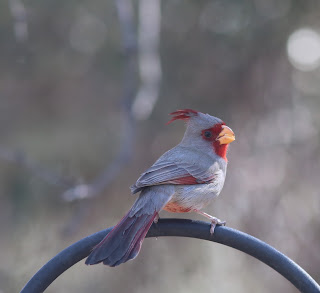I decided I have not been giving enough attention to the ordinary birds at our feeders, so that is what I am going to try to do here.
We have a porch that goes along the back of our house and gives a view out along our back yard, the land sloping away from us, so that the porch overlooks the scene from above. Immediately below the porch is a flat area that has a pole standing up about eight or ten feet tall with a cut-out of a bird on top, and a short arm on each side. On one arm a little cage full of peanuts is hanging, on the other a block of suet.
Gila Woodpecker:
There is no time of day we can't see or hear from one to eight Gila Woodpeckers dominating all the feeders. They are there first thing in the morning, sitting on some aluminum thing on the roof and giving it a quick drumming to be sure we are all awake. Then they come sweeping into the feeders, bossing all the other birds away from them and calling out deafeningly their repeated Pow! Pow! Pow! like bullets striking garbage can lids. If another bird doesn't get out of their way instantly they begin jabbing it in the stomach with their heavy woodpecker bills. They are gray on the underside except for a bright yellow belly, and from neck to tail on the back they have a "ladderback" marking.
Ladder-backed Woodpecker:
This second bird, also very common, and also having a "ladderback" pattern, is much smaller than the Gila and much more demure and peaceful, and in addition to its smaller size it has a black line on the back of it neck. On this species the very attractive male has the whole top of the head red, on the Gila (I didn't show a male) only a small circle on top of the head is red. The female Ladder-back has no red and a very noticeable black line on the back of the neck. Some men working in our yard recently wondered if the bigger ladderback (the Gila) was the mother, and the smaller was its child.
These two woodpeckers are with us all year. Very occasionally we see a flicker here. Otherwise no other woodpeckers at all.
In the summer we have Lucy's Warbler here as a common breeding bird, but as I am writing this (the beginning of March) they have not arrived yet. We haven't lived here long enough to work out if there is a regular migration of warblers passing through the yard. But we have two species of warblers that stay with us through the winter, usually only one or two of each.
Orange-crowned Warbler:
The Orange-crowned Warbler is a quiet yellowish bird with a sweet tooth, that comes to grape jelly feeders that are put out for Verdins and Orioles.
Yellow-rumped Warbler
Or better known as Butter-butt, this species remains farther north in winter compared to other warblers. Most warblers feed mainly on insects and so couldn't remain in the snowy insectless north, but the Yellow-rumps can make do with berries and the suet cakes bird lovers put out for them. Usually their pattern and plumage are immaculate. This one I found to take a picture of unfortunately is a little bit rumpled, but he's still quite handsome.
END OF PART ONE












